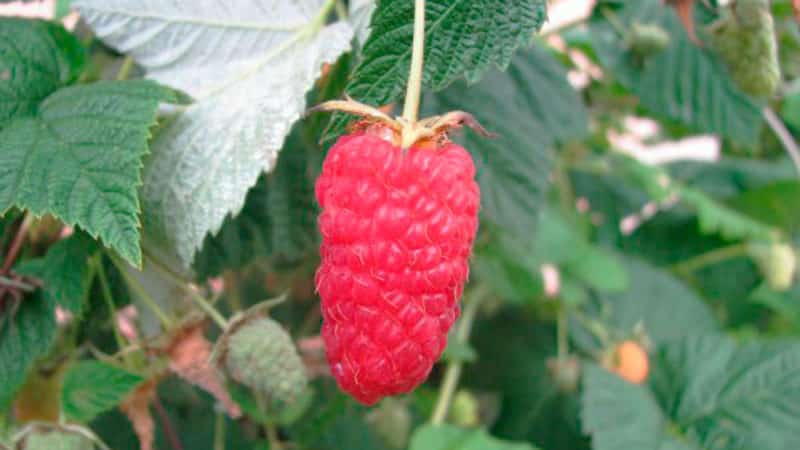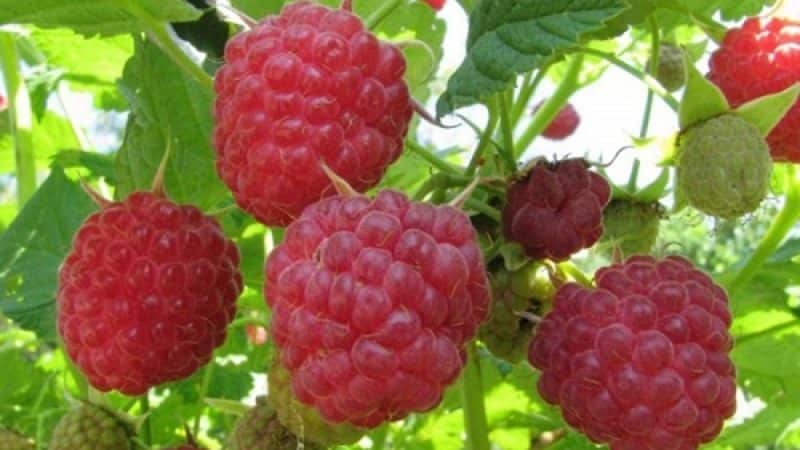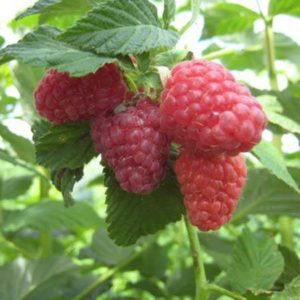New raspberry variety Daughter of Hercules: description and characteristics, planting and care rules
Raspberries are one of the most favorite berries in Russia. Its fruits have a special rich aroma and a pleasant sweet-sour taste. They are eaten fresh and processed into jam, which is eaten in winter as a cure for colds. Even the leaves and shoots of this plant are fragrant and tasty, which is why it is popular and breeders all over the world are actively working on it.
One of the most successful varieties, according to many gardeners, is the Daughter of Hercules. Such raspberries are resistant to most diseases and pests, large-fruited and high in yield. However, when growing it, it is worth considering several nuances.
Description of the remontant raspberry variety Daughter of Hercules
Daughter of Hercules is a relatively young remontant variety. It is considered an improved variation of the Hercules variety.
Raspberries Hercules and Hercules' Daughter have the same description. However, the improved version is characterized by increased winter hardiness and disease resistance. Also, the Daughter of Hercules branches more strongly than Hercules, and has even larger fruits.
Main characteristics

Raspberry Daughter of Hercules is popular with both experienced and novice gardeners. The plant has excellent characteristics that allow it grow in most regions of our country.
Description of raspberry Daughter of Hercules:
- The bush is medium spreading. Every year it forms from 2 to 5 shoots. This makes it easier to form. The branches are powerful and do not break under the weight of the fruit. The height reaches 2 m.The stems are erect, covered with long thorns. At the beginning of summer, young shoots have a green tint, but by autumn they turn red.
- The leaf blade is medium-sized, dissected. The color is bright green. The bush is abundantly leafy.
- The fruits are large. The weight of one berry is 10-20 g. They have an oval or ovoid shape. Dense, juicy, but not watery. When ripe they have a dark red hue. Unripe fruits are green or brown. They have a pronounced raspberry aroma. The taste is delicate, sweet with a slight sourness. Suitable for fresh consumption and preservation.
- The yield is high - up to 10 kg of berries per harvest from a bush. The Daughter of Hercules gives it twice during the season.
- In terms of ripening, the variety is late-ripening. The fruits are harvested from August to October.
- Transportability is high. Dense, strong fruits do not wrinkle during transportation.
Features of the variety
The daughter of Hercules is famous not only for its large berries. The variety has a number of other features:
- Immunity. It is resistant to viral and fungal diseases. The plant is rarely attacked by pests.
- Frost resistance. Tolerates cold winters well. Due to its late ripening, it is suitable for cultivation in the southern and central, but not in the northern regions.
- Maintenance. Fruits are formed on the shoots of the previous and current year. The first berries are formed already in the year of planting.
- It requires light, so it is planted only in well-lit areas.
- Demanding on humidity. But with high humidity, the shoots rot.
In the central regions, berries from the second harvest do not always have time to ripen before frost. In this case, the shoots with fruits are cut off and placed in water at room temperature. After a few days they ripen.
Advantages and Disadvantages of Daughter of Hercules

Before purchasing the Daughter of Hercules, you should familiarize yourself with the advantages and disadvantages of the variety.
Let's look at the advantages first:
- immunity to viral and fungal diseases;
- high productivity;
- winter hardiness;
- ease of formation;
- rapid rooting of cuttings;
- rich aroma;
- large fruit;
- undemanding to soil composition;
- repairability.
The variety also has disadvantages. They are also worth considering:
- Some gardeners consider the presence of sourness in the taste of berries to be a relative disadvantage;
- late ripening is an obstacle for those who live in the northern and central regions;
- the presence of thorns on the shoots that make it difficult to pick berries;
- small increase in shoots for propagation.
The disadvantages of such raspberries are relative. Some gardeners consider them to be advantages.
Landing
Raspberry Daughter of Hercules will be a reward for gardeners who take care of their plot. It will bear a large number of fruits every year. But to appreciate all the advantages of this variety, it is important to plant it correctly.
Site selection and preparation
Growing raspberries begins with choosing a suitable site and preparing the soil. Depends on ease of care for plantings and whether they will get sick.
Raspberries need a well-lit area of the garden, protected from the wind. This plant is often planted near the fence.
The location should not be where groundwater is close to the surface. It is better to place the raspberries on a hill. This will prevent water from stagnating after precipitation.
Note! Daughter of Hercules is sensitive to waterlogging. In such conditions, it begins to hurt and rot.
If there was a raspberry patch in the chosen location, green manure plants - legumes, lupine, wheat, etc. - are planted there a year before planting new shrubs.
Nutritious loose soil with low acidity is suitable for raspberries. In acidic soils, the plant will produce fewer fruits.
At least a month before planting raspberries, it is recommended to prepare the soil - add 13 kg of rotted manure, 45 g of potassium sulfate and 60 g of superphosphate per 1 m². The soil is dug up and leveled with a rake.
2-3 days before planting, the soil is disinfected. To do this, water it with a solution prepared from 1 tbsp. l. copper sulfate and a bucket of water.
Landing rules
Seedlings of the Daughter of Hercules are sold in nurseries and on the market. They must have a developed, preferably closed root system and elastic branches. The planting material should not show signs of disease or damage.
Advice. Can be used as planting material trimmings, remaining after formation.
It is easy to propagate the daughter of Hercules yourself using cuttings. To do this, select the branches of the current year. Cut shoots 12-15 cm long. They should have several living buds.
The cuttings are soaked for 30 minutes. in a light pink solution of potassium permanganate. Then they are immersed for a day in the root formation stimulator “Heteroauxin”. The same is done with ready-made seedlings, but in this case only the root system is treated.
The cuttings are planted in a fertile mixture consisting of peat, garden soil, sand and humus. They are buried so that they can stand without support. The soil around them is compacted and watered.
To create high humidity, a greenhouse is collected. Sometimes it is replaced with a transparent bag placed on a branch. The cuttings are ventilated daily and sprayed with warm water. Water as the soil dries. The rooting of planting material will be indicated by awakened buds.Seedlings are planted in a permanent location in early spring or autumn.
Note! If the seedling has a dark brown or black tint, this indicates that it has suffered from frost.
There are several schemes for planting raspberries:
- Tape. In this case, trenches are dug at a distance of 1.5 m from each other. The distance between plants in them should be 70-90 cm.
- Triangular. Groups of three bushes are formed into triangles with sides of 50-60 cm. The distance between them should be 1.2-1.5 m.
- Square bush. Bushes are planted in rows. Use a 1×1 m or 1.5×1.5 m scheme.
- Curtinny. Raspberries are planted in groups of 3. The distance between them should be 60 cm.
In any of the options, the technique for planting raspberries is the same:
- The seedling is shortened by 1/3.
- A mound of fertile soil is poured into the place where the bush will be located.
- A seedling is placed in the center, evenly distributing the roots around the earthen mound.
- The free space is covered with earth so that the root collar of the seedling is not buried.
- The soil around the bush is compacted and mulched with peat or humus.
- Water with warm, settled water.
Plant care

In order for the Daughter of Hercules to develop quickly and bear fruit abundantly every year, she must be properly cared for:
- Watering. Remontant varieties are watered every week. It is important to ensure that the water does not stagnate, as this will lead to rotting of the roots. If there has been precipitation, do not water the raspberries. In very hot and dry weather, the frequency of watering is increased to 2 times a week. For irrigation use settled warm water. The soil is moistened in the morning or evening, when the sun is inactive, so that burns do not appear on the leaves of the plant.
- Formation. All old shoots are cut out.Only fruit-bearing shoots from last year and branches of the current year are left. The procedure is carried out with a disinfected pruning shears in the morning or evening. The cut areas are lubricated with garden varnish. On the day of pruning, the plant is not watered. There should be 6 to 8 shoots left on the bush.
- Garter. Despite the fact that the branches of the Daughter of Hercules do not break, but bend under the weight of the fruit, it is recommended to tie the shoots to a support. This makes it easier for the plant to grow.
- Loosening. The next day after watering and precipitation, the soil is loosened to a depth of 8-10 cm to destroy the earthen crust, which impairs air exchange in the roots and promotes stagnation of liquid.
- Mulching. Be sure to mulch the soil around the raspberries every year with humus, peat or rotted straw. This layer protects the roots from frost and pests, slows down the growth of weeds, acts as an additional fertilizer, and reduces the need for loosening.
- Feeding. Fertilizers added to the soil when planting a seedling are enough for a year. Raspberries begin to be fed from the second year of life. During the season, nutrient mixtures are applied 4-5 times. The soil is first moistened.
- Preparing for winter. in autumn the bush is removed from the support. Cut branches and thin stems are placed on it. The mulch layer is raised as high as possible. In winter, raspberries are covered with snow. If the winter is not snowy, it is covered with spunbond.
- Pinching. To increase the yield of the plant, shoots that have reached a length of 1 m are pinched - the tip 5 cm long is broken off.
It is recommended to plant fragrant flowers (tobacco, oregano, thyme) near raspberries to attract pollinators.
Feeding
When growing raspberries, use the following scheme:
- In the spring. At the beginning of spring, mineral fertilizing is applied.It is prepared from 10 liters of water, 60 g of superphosphate and 40 g of potassium sulfate. Half a bucket is poured under 1 bush.
- At the beginning of summer apply organic fertilizers. They are prepared from rotted manure, diluted in a ratio of 1:10 with water and infused for 3 days, or from chicken manure, diluted in a ratio of 1:20.
- At the end of July apply mineral fertilizers. You can prepare fertilizer from 0.5 kg of ash and 5 liters of water.
- In August use complex fertilizer. Often a solution of chicken droppings or rotted manure is prepared with the addition of 2 tbsp. ash in a bucket.
- in autumn add mineral fertilizers and humus. 1 tsp is poured under the bush. potassium and phosphorus fertilizer, as well as a bucket of humus.
Diseases and pests

The daughter of Hercules has high immunity. Therefore, it is extremely rarely affected by diseases. Pests attack fruit and berry bushes more often.
To avoid possible problems, you must follow the rules of prevention:
- Soil, planting material and garden tools are disinfected before use.
- Raspberry plantings do not thicken. The soil around the plant is weeded. Old branches must be cut off.
- In spring, the plant is sprayed with Bordeaux mixture or copper sulfate solution.
- In autumn, all plant debris is removed from the site and burned.
- Follow watering rules. Make sure that the liquid does not stagnate. Do not use water from a hose.
Conclusion
Daughter of Hercules is one of the best raspberry varieties. This is an improved version of the well-known Hercules. It has higher productivity and large fruits, resistance to diseases, ease of rooting, high winter hardiness. This variety is superior to its ancestor in several respects.
Growing Daughter of Hercules raspberries is not difficult.The variety is easy to care for and is suitable for cultivation in a summer cottage. Even with minimal care, gardeners receive more than 15 kg of harvest per year from one bush. The main thing is to fertilize, water, and ensure that the water does not stagnate in a timely manner.